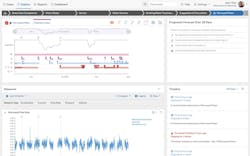Cost savings are often attributed to unplanned downtime avoidance, but some say this point often confuses “cost savings” with “cost avoidance.”
At the Manufacturing in America event in Detroit, co-sponsored by Siemens and Electro-Matic, Alexander Hill, head of business development at Senseye Predictive Maintenance (a software supplier acquired by Siemens in 2022), agrees with those who say the ability to avoid unplanned downtime is not a cost saving, but a cost avoidance. “Manufacturers need to find real cost savings,” he said. “Savings attributed to unplanned downtime avoidance is a wooden nickel because you can’t buy anything with those ‘cost savings.’”
The disconnect between “costs savings” and “cost avoidance” around downtime is due to the fact that downtime is not a commonly budgeted manufacturing factor because of its varying impact across industries based on production processes.
However, there are real, bottom-line savings to be captured that justify asset intelligence expenditures to mitigate equipment downtime. These savings can be quantified around reduced costs and risks, increased sustainability, support for mobile workers, more precise and correct maintenance, and increased production equipment availability, said Hill.
Such savings can be attributed to:
- 24% of total manufacturing costs for a product can be attributed to downtime.
- 90% of maintenance is crisis work to fix breakdowns.
- 300% of downtime is under-reported because it was fixed quickly.
He added that unplanned downtime is estimated to cost manufacturers between $10,000/hour and $3.5 million/hour, depending on the size of the manufacturer and value of the product being produced.
Not a Big Data project
Senseye’s approach to asset intelligence involves the use of artificial intelligence (AI) and machine learning (ML) to automate predictive analytics for any kind of machine with the goal of having the resulting asset intelligence deliver quantifiable business outcomes. The web-based software “uses ML as its base with AI on top that fuses human maintenance input to learn what’s most important about the machine,” Hill said. “We don’t want high-frequency condition monitoring data [with Senseye]. We look at time series data from sensors measured periodically at a consistent machine state. These data expose machine degradation and reduce noise related to mechanical conditions.”
Hill added that asset intelligence via Senseye’s approach is “not a Big Data project because it looks at very specific data.”
Examples of the kind of data Senseye tracks include torque per axis, input and output pressures, and motor current. “It’s a one-way data push from the data source to Senseye, so there are no security issues,” he noted.
Hill added that the Senseye software can connect to any kind of sensor, asset or system with typical outcomes being a 50% reduction in downtime reduction and a 30% increase maintenance efficiency within 3-6 months.
Adding value to low-quality data
“The currency we deal with is human attention,” said Hill. “Most people want to talk about machine health, but often do so by dealing with low-content, low-quality data which can drive spending on additional sensors to get more or better data. Senseye’s approach is to use AI/ML against low quality data to add value to it via the software’s ability to interface with existing historians, CMMS (computerized maintenance management system) or MES (manufacturing execution system) to maximize data you already have.”
Senseye then evaluates where it makes sense to commit any additional investments around additional data gathering, if needed.
According to Siemens, Senseye can be used directly by maintainers working remotely or on the shop floor. The company claims it’s “the only predictive maintenance application to build models of machine and user behavior. This approach allows our AI to work collaboratively with your maintenance team, enhancing knowledge and expertise.”
Automotive industry application
In his presentation, Hill referenced a large Detroit automotive manufacturer Senseye began working with in 2016. “We started working with them on tens of assets,” Hill said. “Senseye is now being used on more than 2,500 assets across more than 100 different asset types in nine factories.”
He added that, at this automotive manufacturer, the team of three people that started on the project are still all that is required despite the vast increase in use of Senseye at the company.
“Any software vendor can do predictive maintenance,” Hill said. “But to scale, it has to be automated—business outcomes are achieved via scale. Senseye’s use of AI to analyze data is key [to its scalability].
Combining asset data and human inputs
Senseye uses AI to match and analyze data to highlight which machine(s) maintenance workers should be focusing on and why. Users can see where problems exist and then input data about the associated maintenance work event to drive the AI further.
“It’s based on what’s important to the business—where they want to save money,” Hill said. “Senseye shows how much downtime, labor costs, penalties, etc. are avoided. This gives finance the information they need to assess actual costs saved, not just those avoided.”





